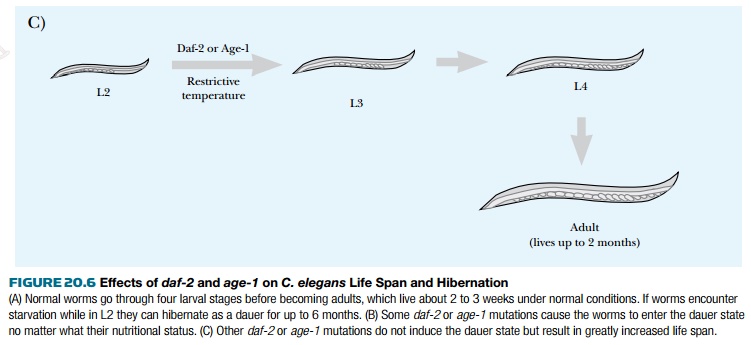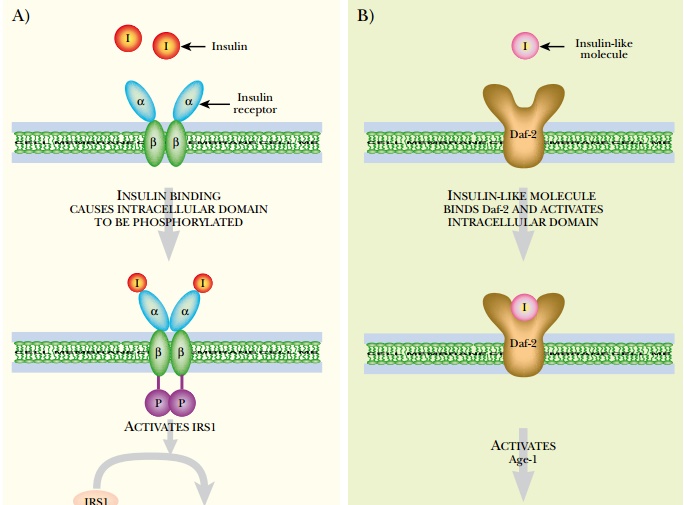Chapter: Biotechnology Applying the Genetic Revolution: Aging and Apoptosis
Life Span and Metabolism in Worms
LIFE
SPAN AND METABOLISM IN WORMS
The role of metabolism and nutrition in
aging has been revealed by studying the nematode worm C. elegans , which
normally lives for 2 to 3 weeks. Several mutations are known that increase the
life span and/or the worm’s entry into a type of hibernation called dauer (
Fig. 20.6 ). Normally these worms go through four larval stages before they
become adults. When there is not enough food or water, a worm goes into the
dauer stage. It produces a thicker cuticle to prevent dehydration and closes
off its mouth and anus so it cannot eat. It does not feed or move until
stimulated with more food or water. Some mutations in the genes daf-2 and
age-1 cause the worms to enter the dauer stage. Many of these mutations
are temperature sensitive , that is, the mutation is fully expressed only at
higher temperature. Other daf-2 or age-1 mutations cause an increased
life span, of up to 2 months, without inducing the dauer stage.


The Daf-2 and Age-1 proteins both
regulate metabolic rate ( Fig. 20.7 ). According to sequence data, Age-1 encodes
a worm homolog to the catalytic subunit of phosphatidylinositol-3-kinase (PI3K),
and daf-2 encodes a homolog to the insulin receptor. The mammal homologs
of these two proteins are involved in insulin signaling. When this pathway is
impaired in humans, we develop type II diabetes (adult-onset). The worm
mutations in daf-2 and age-1block the signal transmitted by the
insulin-like receptor. By analogy with the human system, the worm mutations
probably affect glucose levels, lower the metabolic rate, and hence extend life
span. In support of this, daf-2 and age-1 worms show lower
metabolic rates than wild-type and more resistance to oxidative damage.


Another set of mutations in C. elegans also increases the average life span of the worm. These genes are called clk , for abnormal function of biological clocks, and gro , for growth rate abnormal. These mutations lengthen the time it takes for the worm to go through embryonic development and postembryonic development, ultimately increasing the life span. The whole developmental process is delayed. Unlike daf-2 and age-1 , mutations in clk or gro have absolutely no effect on dauer formation. The closest homolog of CLK-1 is a yeast protein that is involved in growth regulation and allows the cells to switch from a fermentable carbon source like glucose to a nonfermentable one. The yeast protein controls the synthesis of ubiquinone, an electron carrier involved in mitochondrial respiration. So, once again, the extension ofC. elegans life span boils down to an altered rate of metabolism. The mitochondria of clkmutants release smaller amounts of reactive oxygen metabolites, and aging is slowed.
Related Topics